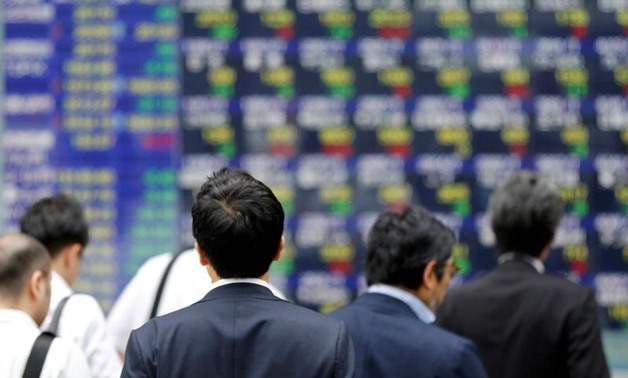
FILE PHOTO: People walk past an electronic stock quotation board outside a brokerage in Tokyo, Japan, September 22, 2017. REUTERS/Toru Hana
TOKYO - 5 March 2019: Asian shares stepped back on Tuesday, weighed by U.S. economic concerns and as China cut its growth target in the face of intensifying challenges from rising debt and a dispute over trade and technology with the United States.
Beijing lowered the growth target for this year to 6.0 to 6.5 percent, as expected, from around 6.5 percent last year and offered more stimulus, including cuts in taxes and social security fees, increases in infrastructure investment and lending to small firms.
European shares are seen steady to slightly lower, with spread-betters expecting Britain’s FTSE and France’s CAC to open flat and Germany’s DAX to dip 0.2 percent.
MSCI’s broadest index of Asia-Pacific shares outside Japan dropped 0.15 percent and Japan’s Nikkei lost 0.4 percent.
While Asian shares were broadly weaker, China’s spending plans gave mainland markets some support with the blue-chip CSI300 index briefly gaining as much as 0.5 percent to extend Monday’s nine-month high. It later gave up most of the gains to stand 0.1 percent higher.
“As further details of the economic package will be rolled out in coming days, Chinese share markets could extend gains further near-term,” said Wang Shenshen, strategist at Tokai Tokyo Research Center.
Reflecting lower tax revenue and higher government spending, Beijing has set a budget deficit target of 2.8 percent of GDP, up from last year’s 2.6 percent.
The Finance Ministry set the quota for local government’s special bond issues at 2.15 trillion yuan ($320 billion), 0.8 trillion yuan above last year’s quota.
“The increase in local governments’ special bond is fairly large,” said Naoto Saito, chief researcher at Daiwa Institute of Research.
“Since those funds will be solely used for infrastructure investments, you cannot avoid the impression that the government is relying on investments to support the economy in the short-term rather than de-leveraging. This could cause problems in the longer term.”
BACK TO OCTOBER
Wall Street’s major indexes fell on Monday, with the Dow Jones Industrial Average shedding 0.79 percent and the S&P 500 losing 0.39 percent.
An unexpected fall in U.S. construction spending, data that normally attracts little attention, was cited as a factor.
But others saw the retreat as a long overdue correction after a rally since late last year.
MSCI’s ACWI,, a gauge of 47 markets in the world, has risen 16 percent from its near two-year low set on Dec. 26 low, even as the earnings outlook stagnated, driven by hopes of a dovish Federal Reserve and a compromise between Beijing and Washington on trade.
The index is now trading at 14.6 times expected earnings, on par with levels last seen in early October, when a bear market began globally.
Thus a media report on Monday that U.S. President Donald Trump and Chinese President Xi Jinping could reach a formal trade deal at a summit around March 27 prompted profit-taking rather than follow-through buying.
“If you’re a trader, you’re taking profit now. You buy on the rumour, sell on the news, wait till it goes down, and buy again,” said Sean Taylor, chief investment officer for the Asia Pacific at Deutsche Bank’s asset management arm DWS.
World shares tick higher on U.S.-China trade deal optimism
Taylor said he expects the two economic superpowers to reach a trade deal soon but cautioned that it would not end the tensions.
“It is the Trade War One which will be finished soon. That’s to do with China buying agricultural goods from the U.S. and China opening up more to international markets. But we still see there’ll be the Trade War Two, which will be about intellectual property and about technology,” he said.
The 10-year U.S. Treasuries yield dropped to 2.724 percent after touching from six-week highs of 2.768 percent in the past two sessions.
In currency markets, the dollar held an upper hand against many of its rivals as other major central banks are seen tilting to a more dovish stance than the Federal Reserve.
The euro dipped 0.1 percent to $1.1330 , amid expectations the European Central Bank is preparing to give banks more cheap, long-term funding at its policy meeting on Thursday.
The dollar rose 0.2 percent to 111.93 yen, near a 10-week high of 112.08 on Friday.
The Australian dollar dipped 0.20 percent to $0.7072 after weak net exports reading suggested Australia’s economy came close to stalling last quarter.
The Reserve Bank of Australia (RBA) stuck with its upbeat outlook for the economy, though investors still suspect it will have to cut rates eventually.
Gold stayed under pressure after having fallen for four days in a row by Monday to as low as $1,283.10 per ounce, its lowest level since Jan. 25. It last stood at $1,288.2
Oil prices were little changed, hovering below their recently-hit three-month peaks.
U.S. crude futures stood at $56.38 per barrel, down 0.4 percent in early Asia but still up almost 1 percent on the week.
International benchmark Brent futures were down 0.4 percent at $65.41 per barrel.


Comments
Leave a Comment